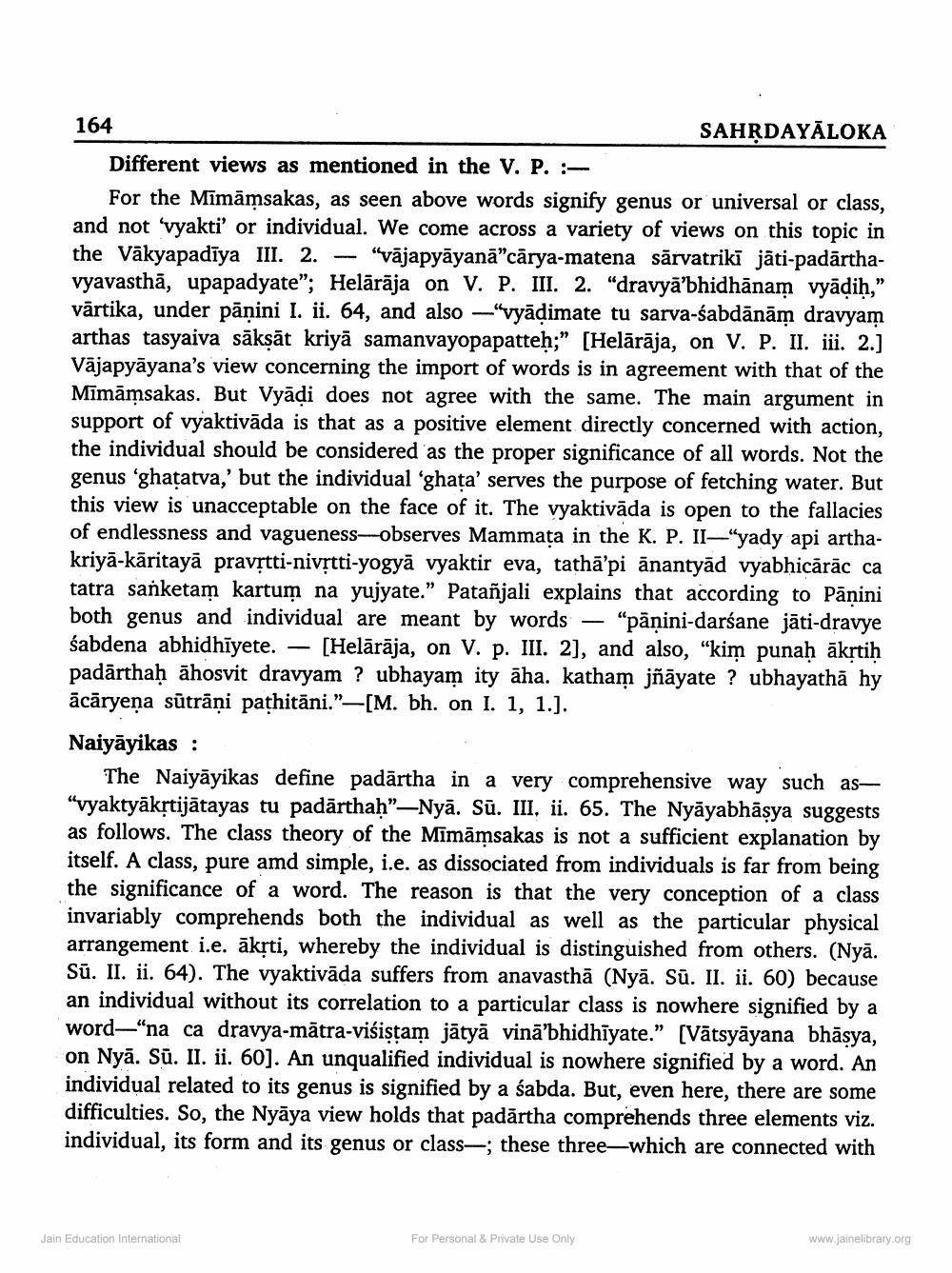________________
164
SAHRDAYĀLOKA
Different views as mentioned in the V. P. :
For the Mīmāmsakas, as seen above words signify genus or universal or class, and not 'vyakti' or individual. We come across a variety of views on this topic in the Vākyapadīya III. 2. - "vājapyāyanā"cārya-matena sārvatrikī jāti-padārthavyavasthā, upapadyate"; Helārāja on V. P. III. 2. "dravyā'bhidhānam vyādih," vārtika, under pānini I. ii. 64, and also “vyādimate tu sarva-sabdānām dravyam arthas tasyaiva sākṣāt kriyā samanvayopapatteh;" [Helārāja, on V. P. II. iii. 2.] Vājapyāyana's view concerning the import of words is in agreement with that of the Mīmāmsakas. But Vyādi does not agree with the same. The main argument in support of vyaktivāda is that as a positive element directly concerned with action, the individual should be considered as the proper significance of all words. Not the genus 'ghatatva,' but the individual ‘ghata' serves the purpose of fetching water. But this view is unacceptable on the face of it. The vyaktivāda is open to the fallacies of endlessness and vagueness-observes Mammaţa in the K. P. II—"yady api arthakriyā-kāritayā pravstti-nivịtti-yogyā vyaktir eva, tathā'pi ānantyād vyabhicārāc ca tatra sanketam kartum na yujyate.” Patañjali explains that according to Pāṇini both genus and individual are meant by words – “pāņini-darśane jāti-dravye sabdena abhidhīyete. — (Helārāja, on V. p. III. 2], and also, “kim punah akrtih padārthah āhosvit dravyam? ubhayam ity aha. katham jñāyate ? ubhayathā hy ācāryena sūtrāni pathitāni."-[M. bh. on I. 1, 1.).
Naiyāyikas :
The Naiyāyikas define padārtha in a very comprehensive way such as"vyaktyākrtijātayas tu padārthah"-Nyā. Sū. III. ii. 65. The Nyāyabhāsya suggests as follows. The class theory of the Mīmāmsakas is not a sufficient explanation by itself. A class, pure amd simple, i.e. as dissociated from individuals is far from being the significance of a word. The reason is that the very conception of a class invariably comprehends both the individual as well as the particular physical arrangement i.e. āksti, whereby the individual is distinguished from others. (Nyā. Sū. II. ii. 64). The vyaktivāda suffers from anavasthā (Nyā. Sū. II. ii. 60) because an individual without its correlation to a particular class is nowhere signified by a word—“na ca dravya-mātra-visistam jātyā vinā'bhidhīyate." (Vātsyāyana bhāsya, on Nyā. Sū. II. ii. 60). An unqualified individual is nowhere signified by a word. An individual related to its genus is signified by a sabda. But, even here, there are some difficulties. So, the Nyāya view holds that padārtha comprehends three elements viz. individual, its form and its genus or class; these three-which are connected with
For Personal & Private Use Only
Jain Education International
www.jainelibrary.org




